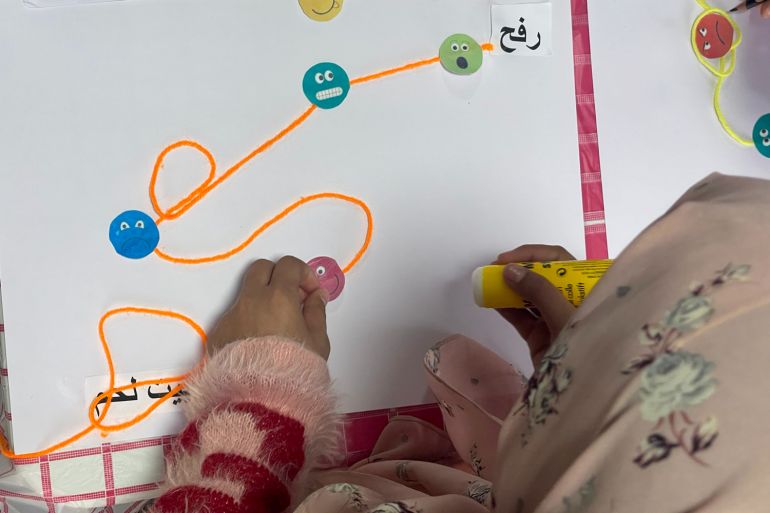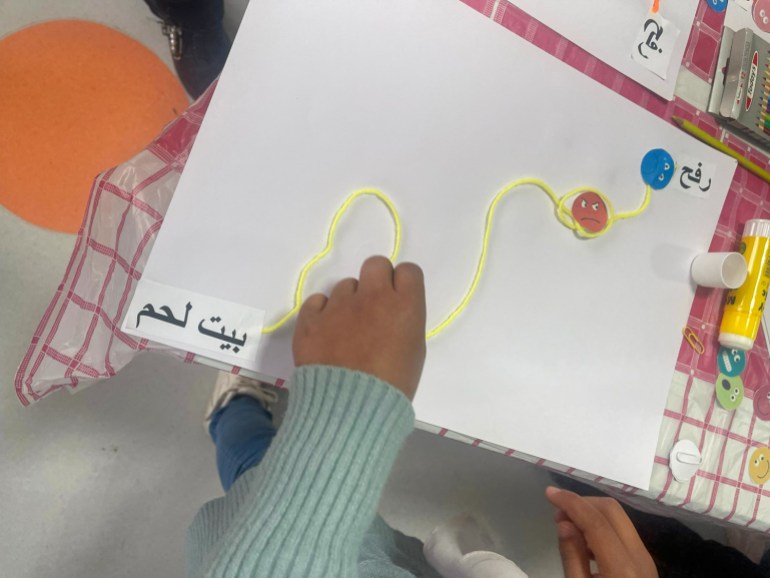These children left Gaza but still suffer mental trauma from Israel’s war
Through art and bonding with each other, 68 children evacuated to Bethlehem are working through their pain.

Bethlehem, occupied West Bank – A group of children from Gaza are in an art workshop in Bethlehem’s SOS Children’s Village, 102km (63.4 miles) from Rafah, the southernmost city in the Gaza Strip.
The children are working on depictions of the three-day journey they took from Rafah to Bethlehem, a convoluted journey to cover a distance that could be driven in an hour.
Keep reading
list of 3 itemsOver 13,000 children killed in Gaza, others severely malnourished: UNICEF
Six children in Gaza starve to death as hunger crisis worsens
Like all Palestinians, their movement is constrained by the Israeli government, which severely limits the ability of Palestinians to move around in normal times, a situation made worse by the war Israel is waging on Gaza.
Sixty-eight children were evacuated this month from Rafah’s SOS Children’s Village to the charity’s facility in Bethlehem, accompanied by 11 caregivers who were looking after them in Gaza with the support of the German government.
Expressing pain and fear
For their comfort and privacy, the children – aged two to 14 – cannot be interviewed or photographed directly, but Al Jazeera was allowed to observe their workshop and interactions.
One girl was focused on cutting out the word “Rafah” and glueing it to a corner of her sheet with a sad, scared, frowning face glued sideways next to it.
From there, she wound bright yellow yarn down the page, wrapping it in a loose knot around an angry face, then winding it in big loops until it reached “Bethlehem”, which she had glued in the opposite corner.
Already close-knit because of how SOS Villages are structured, the children seem to have gotten even closer during their long journey to Bethlehem.
One boy leans over and patiently helps a younger boy figure out what to do with his sheet, explaining that the different faces were there for the little boy to express how he felt at different points in the journey and waiting for his younger friend to position them before explaining the glue stick.
At the other end of the room, a five-year-old boy has gotten tangled in his jacket because the sleeves are inside out. His 14-year-old buddy takes it off and sorts it out, putting it back on him and pulling him close to her for a big hug once he is ready to join the activity.
Dr Mutaz Lubad, an expert in art and psychological therapy, says this guided art session allows the children some release, to open up a space for them to express what is on their minds through their art.
The children are processing a daunting mix of emotions: sadness at leaving their home as well as several children whose families did not approve their evacuations, relief to be getting away from the war, fear of loud noises after experiencing bombings, fleeting happiness at getting to Bethlehem and dreams of going home to Rafah.

“Because children often find it difficult to express what they’re feeling verbally, we work on looking into their struggles through their art,” Lubad told Al Jazeera.
In guided art activities like this one where everyone is asked to produce the same thing, the children are able to choose their colours, the expressions on the faces they pick for different points in their journey and how convoluted they make the glued yarn to represent their three days of travel.
Asked about the significance of some children putting loose knots into their yarn journeys, Lubad said: “The knots represent points where the children were exposed to situations that confused or scared them, but the fact that they by and large used loose knots shows that these are things they feel they are able to overcome.
“One boy’s piece was especially expressive. When he was told he would be moved from Rafah, he feared the unknown, feared leaving his room and home. Then during the trip, he was worried and stressed by turn until, finally, he was relieved to be safe in Bethlehem. All that is shown in the expressions on the faces he chose.”
Protecting the children
The Rafah SOS Village is still open and receiving children whose families have died in the war or who have become separated from their relatives. There are several children who remained in the Rafah facility after their legal guardians refused their evacuation from Gaza.
Maintaining contact with the children’s families – if they have any – is an important part of maintaining their community ties, but trying to find out which relatives have survived and which have died has been nearly impossible, Sami Ajur, programme manager at the Children’s Village Foundation in Gaza, tells Al Jazeera.
Despite the difficulties the foundation is facing during the war, it is continuing its work, he adds, pointing out that the Rafah facility is actually seeking support to expand its operations so it can receive more of the children being orphaned or separated from their families every day in Gaza.
The trauma the children are experiencing due to the war on Gaza manifests in many ways, including anxiety, incontinence, nightmares and insomnia, Ghada Harazallah, national director of the Children’s Villages in Palestine, says, adding that their mission – protecting the children – has not changed.
At sunset, the children from Gaza and the children who live in the Bethlehem Village will have a group iftar to break their Ramadan fast.
The structure of SOS Children’s Villages worldwide encourages a family-style relationship among the children and between them and the adult staff. One staff member is assigned as a “parent” to each group of children, who are raised in “family” clusters where they can bond with each other.